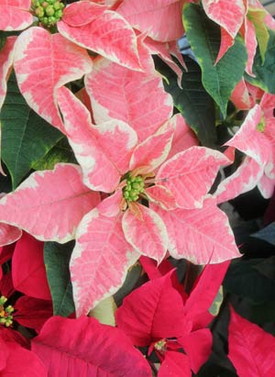 It’s that season and they are everywhere, red, pink, white and everything in between. No, not Santa’s elves, but poinsettias. A scraggly bush in the tropics, it has become the plant that claims Christmas.
It’s that season and they are everywhere, red, pink, white and everything in between. No, not Santa’s elves, but poinsettias. A scraggly bush in the tropics, it has become the plant that claims Christmas.
When we lived in Africa, on the equator, it bloomed in the wild. But not on the highways under the street lights, because, to set buds, poinsettia must have long hours of absolute blackness at night.
So how did a bush like this become the symbol for Christmas? It seems that in 1912, in California, nurseryman Paul Ecke began selling them as cut flowers. Then he developed the first cultivar that would grow as an indoor plant, and for the next 50 years, sent his patented cuttings all over the world. Then some large European corporations made minute variations and stole the patent rights. So much for Christmas generosity.
When I visited the Ecke greenhouses in California, a third generation Ecke shared a few tips.
HOW TO BUY POINSETTIAS. Always have the plant wrapped in paper, even on the top because they loose their leaves from the slightest cool breeze. Pick a
bushy plant with bright, fully colored bracts and a tight, tiny yellow center (the actual flower). If a branch breaks off, put it in water as a cut flower.
HOW TO CARE FOR THEM. Water when the surface of the soil is dry to the touch, but hopefully before the leaves droop like a dogs tail. Punch holes in tinfoil pot covers so water can drain out for they abhor wet feet.
AFTER A WHILE the green leaves fall off because of too much water, not enough water, cold drafts or poor light. However the colored bracts often hang on for months. To hide the bare stems, set pots of foliage plants on top of the soil.
TO KEEP AS A HOUSE PLANT AFTER WINTER. When you are sick to death of looking at the plant (and I guarantee you eventually will be), cut it back to 6 inches. Bright green shoots will grow, which can be cut back again to encourage side shoots. It can go outdoors in summer.
TO GET COLORED BRACTS TO REAPPEAR requires total darkness for 14 hours a day (not a crack of light) plus 10 hours of bright light. It takes 3 months. If you are compulsive and lucky, the bracts (which are actually colored leaves) may appear. I’ve tried this, and for my money, I’d rather just buy them in bloom.
Ruth S. Foster is a landscape consultant and arborist. More gardening information can be found on her website: www.mothersgarden.net.
Credit: www.mothersgarden.net




























